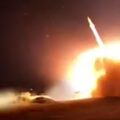 Iran’s Attack on Israel
Iran’s Attack on Israel
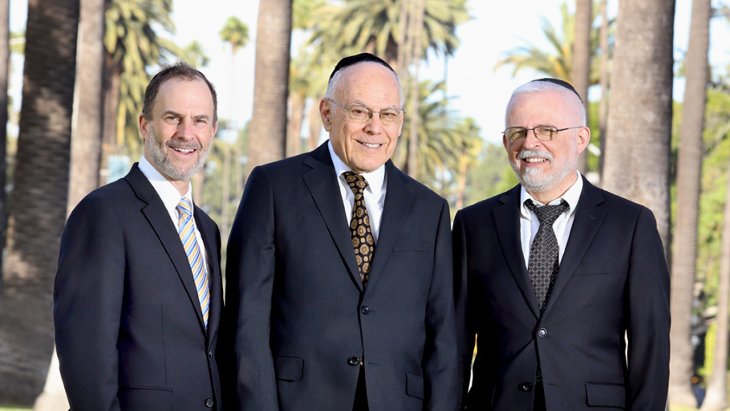

11 min read
How Aish Los Angeles helped transform a Jewish neighborhood.
Walking down Pico Boulevard in sunny Los Angeles, my tour guide exuberantly points to the Jerusalem stone facade at the corner of Pico and Doheny. “To build our outreach center, we combined a former bakery and a Mexican restaurant," explains Rabbi Aryeh Markman, Executive Director of Aish LA. "A few doors down, the former fish store is now a shul, and next to that is a grocery store we converted into a trendy outreach facility for young professionals – Morry's Fireplace."
From a dormant Jewish community 35 years ago, Pico-Robertson has expanded – like dripping water, one storefront after another – into the flourishing Jewish life so evident today. With top-tier rabbanim, a panoply of Torah flavors, family-oriented suburban feel, sunny year-round weather, burgeoning restaurant scene, and young, eclectic vibe, Pico-Robertson's residents insist that among diaspora communities, theirs is second to none.
In a 20-minute stroll down Pico – the “kosher corridor” from Roxbury to Crescent Heights – I encounter 30 shuls, kollels and outreach programs: Persian, Modern Orthodox, kiruv, yeshivish, Chabad, Carlebach, Yemenite, Chassidic, Israeli. There are boutique shuls for musicians and artists; one for Moroccans and another French-Moroccan. Plus 30 kosher restaurants!
"In this case, variety is perfect for the 'age of customization'," Markman says, waving his hands down Pico Boulevard and drinking it all in. "It's like a garment district or diamond district. Every new shul and restaurant solidifies Pico-Robertson as a world-class Torah destination."
Things weren't always this way. Over the decades, various forces conspired to turn Pico-Robertson into a Torah boomtown.
If Pico-Robertson could talk, it would tell us about Dick Horowitz. A high-powered life insurance salesman and (at that time) a Conservative Jew, Horowitz read the 1975 Harvard Jewish Population Study predicting that American Jewry would nearly disappear due to intermarriage. "I'm a numbers person, and saw everything except Orthodox rapidly heading toward zero," Horowitz says from his office in Beverly Hills, where Jewish educational materials adorn the reception area. "As someone who wanted proud Jewish children and grandchildren, Orthodoxy was the obvious answer." (Dick's demographic research later produced the famous chart, "Will Your Grandchildren be Jewish," which appeared in the New York Times and caught the rapt attention of Bibi Netanyahu.)
A 1980 trip to Israel led Horowitz to Rabbi Noah Weinberg zt”l, who articulated a strategy to stop assimilation. Horowitz was determined to import that vision to the American West, and by 1983 launched Aish LA with two dynamic young rabbis, Irwin Katsof and Nachum Braverman. To recruit students, they dug into the Rolodex of Terry Magady, a secular young mover and shaker in business, political, and activist circles who'd recently spent six weeks studying in Israel. (Horowitz bought him the plane ticket, the first of thousands he'd sponsor over the years.)
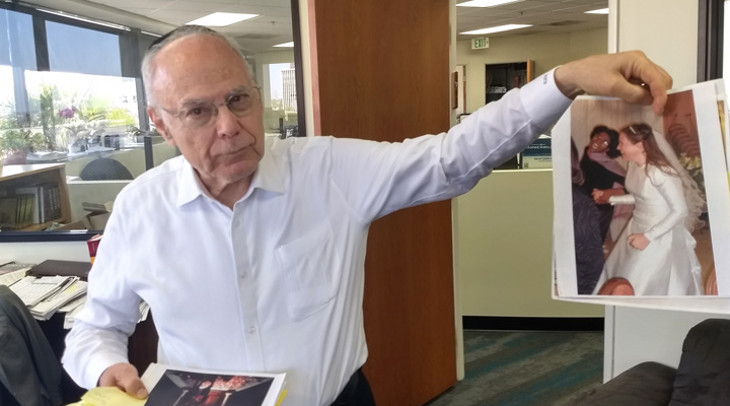 Dick Horowitz in his Beverly Hills office, displaying photos of the
Dick Horowitz in his Beverly Hills office, displaying photos of the
hundreds of LA Jews that he sent to Israel for Torah study.
"The network we built in LA can be traced to that Rolodex," Rabbi Braverman explains, sipping tea at an outdoor cafe on the Pico Strip. "For example, a young photo stylist named Jyl Klein began coming to classes. One Friday afternoon, while on a large photo shoot, Jyl announced she had to leave early because of Shabbos. The Jewish director fired her on the spot. Yet the director – clearly intrigued – attended my class, and subsequently joined the community where she remains active till today."
Slowly but surely, Torah was becoming "cool." Events like the "Love, Dating & Marriage Seminar" at the posh Beverly Hills Hotel brought in a flood of young professionals. Propelled by Katsof's fundraising flair and Braverman's Ivy League sophistication, crowds were lining up on Pico Boulevard to attend Torah events.
"LA attracts imaginative, creative people who are open and receptive to new ideas," Braverman says. "When I tell someone that God spoke at Mount Sinai, it's not the strangest thing they've heard today."
Sure enough, young people became observant, got married, and moved in, aided by the affordable mix of single-family homes and rental apartments. This fresh wave of energy, ideas, and resources catalyzed Pico-Robertson's staid ecosystem, and by the late 1980s, Aish LA's five-star team of rabbis included former Harvard divinity student Dov Heller, British stand-up comic Steve Baars, and Irish Torah scholar Moshe Cohen, who became rabbi of the Aish community.
“From the ground up, we built a unique community entirely of baalei teshuva (returnees),” Rabbi Cohen says. “Most of our people started off at zero, learning to read Hebrew and filling in the gaps of basic Torah knowledge. It was a process of going from Aleph, then to Beis, and onward.”
"We built on the ethos of 'all Jews are responsible one for another’," says Magady, who early on recruited a young attorney named Michael Abramson by sharing a Rabbi Weinberg cassette. Abramson and other newly-minted baalei teshuva – Manny Saltiel, Marc Firestone, David Leventhal, Michael Bonert, Howard Witkin, et al. – reached out to fulfill the exhortation: "If you know aleph, teach aleph."
Rabbi Cohen, whose Community Shul is now an independent entity, assists members in everything from getting married, to setting up a home, to navigating education issues. “When it comes to Torah learning, baalei teshuva often can't keep up with their kids, who know more Talmud than they do. So I tell parents: ‘Look up to your kids, and they won't look down on you.’ Enthusiastically tell your child: 'Wow, you're learning Rashi! I wish I’d had that special opportunity at your age!'"
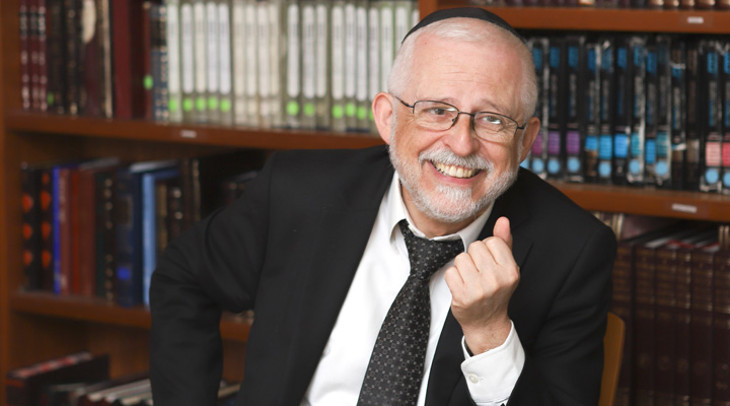 Rabbi Moshe Cohen leads the Community Shul. (photo credit: Jonah Light)
Rabbi Moshe Cohen leads the Community Shul. (photo credit: Jonah Light)
If this neighborhood could talk, it would tell of the perennially-youthful outreach entrepreneur, Rabbi Aryeh Markman. Raised in Chicago with an Xmas tree, Markman spent his early career traveling the globe leading VIP tours for high net-worth individuals. "We visited the most exotic locales," he recalls. "In Moscow I made a clandestine drop-off to refuseniks and got busted by the KGB. It was the most meaningful experience of my life and caused me to consider: If these refuseniks are putting their lives on the line to go to Israel, the least I can do is visit."
Armed with only a backpack and passport, Markman was approached at the Western Wall by Rabbi Meir Shuster and sent to the first-ever Discovery seminar. Convinced of the authenticity of Torah, Markman turned down prestigious MBA programs in order to focus on building the Jewish people. As Director of Aish LA since 1994, he has raised and invested nearly $100 million into Torah programs – in Pico-Robertson, throughout southern California, and in Jerusalem.
Aided by the steady hand of COO Rabbi Azriel Aharon, Aish LA programs have attracted over 60,000 Jews, including families inspired by the Jewish Women’s Initiative (run by Chana Heller and Sharon Shenker) and the Jewish Men’s Initiative. Through Aish LA, 1,000 Jews have met and married; 1,000 children have enrolled in Jewish day schools; and 5,000 have studied in Jerusalem, with Dick Horowitz personally covering credit card debt, school loans, apartment, auto lease, or whatever is necessary to kickstart Torah study in Israel.
On Shabbos in Pico-Robertson, I got my first-hand taste at the table of Rabbi Jack and Shira Melul, who recently joined Aish LA after four years on campus in Oregon. The Meluls host mega-Shabbos tables and inspire young professionals with social media-driven events. As our eclectic, energetic group of guests enjoyed delectable Israeli cuisine, I felt right at home, the memories flooding back of my own family's three years of outreach at Aish LA in the 1990s.
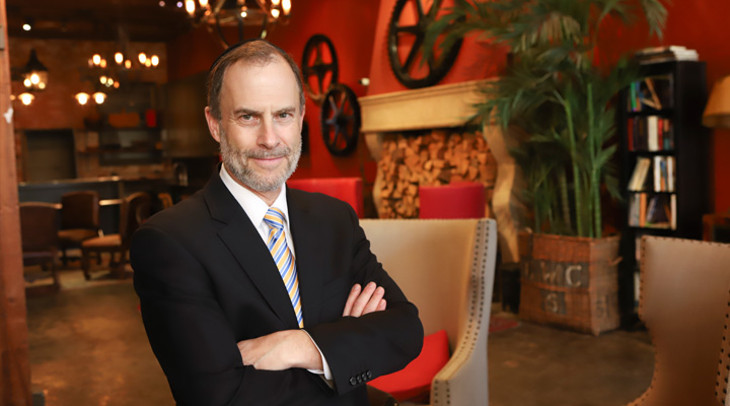 Rabbi Aryeh Markman at Aish LA’s trendy hangout, Morry's Fireplace. (photo credit: Jonah Light)
Rabbi Aryeh Markman at Aish LA’s trendy hangout, Morry's Fireplace. (photo credit: Jonah Light)
No story of Pico-Robertson would be complete without considering its close proximity to the global entertainment industry. "Hollywood has the power of imagination and openness to new ideas," says Emmy Award-winner and Pico resident David Sacks. "And who is more creative than God?”
In promoting Torah, one of the first to recognize the potential of Hollywood was Leibel Rudolph, an award-winning director and producer who, in the early 1990s, studied with Rabbi Braverman and committed his talents to the Jewish world. "Leibel was a creative genius who understood the power of technology, celebrity, and the media to generate buzz," says Katsof, the ambitious, media savvy rabbi who partnered in these grandiose productions. "Leibel made us think big."
The media spotlight shined brightly on Pico-Robertson in 1994 when President Bill Clinton presented an award to Steven Spielberg for his acclaimed Holocaust film, Schindler's List. On stage in front of a massive crowd at the Aish LA banquet, Spielberg declared: "Thank you Aish HaTorah for all the good work you do. I could have used you in my own life 25 years ago!"
In star-crazed Tinseltown, this was high-octane marketing and interest levels soared. At Paramount Studios, TV legend Larry King hosted an Aish international satellite broadcast to benefit kiruv for Russian Jews. Seinfeld co-star Jason Alexander hosted a packed Discovery seminar at Universal Studios. Academy Award-winning actor Elliot Gould shared Torah thoughts with a large group of Aish young professionals.
Rabbi Dov Heller explains some unique aspects of kiruv in the shadow of Hollywood. "With so much superficiality and materialism in LA, there's a lot of social pressure regarding status, externals, financial success, and awards," he says. "People can get caught up in that, pulling them further away from reality. On the other hand, the stark contrast with Torah attracts those with more sensitivity toward meaning in life."
So whether it was Steven Spielberg's mother hosting guests at her Milky Way kosher restaurant on the Pico Strip, or high-powered marketing executive Sarah Weintraub producing Aish LA banquets, or film legend Kirk Douglas walking to the Braverman’s for Shabbos lunch, Pico-Robertson was clearly the "in" place to be.
Today, the neighborhood is a haven for observant Jews in the entertainment industry – successful writers, producers, directors and studio executives. Saul Blinkoff, a member of the Community Shul known for his work with Disney Studios and Dreamworks, says: "On any given day, you can see Hollywood writers at the local Coffee Bean working on a creative script, then switching gears to a Torah study session."
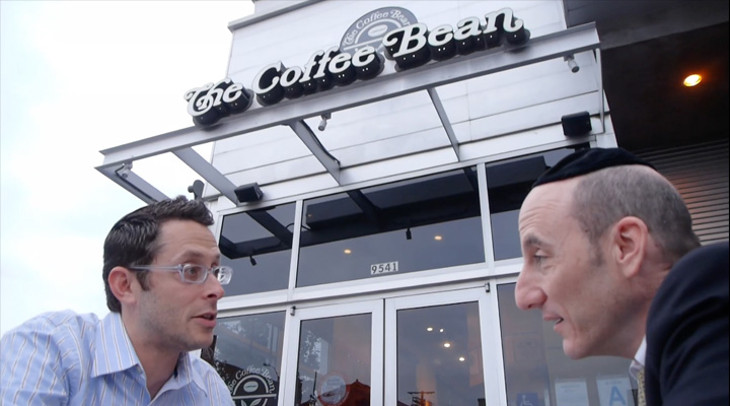 On the Pico Strip: Hollywood animator Saul Blinkoff studies Torah with Rabbi Shalom Denbo.
On the Pico Strip: Hollywood animator Saul Blinkoff studies Torah with Rabbi Shalom Denbo.
Yet for many decades the Pico Strip lacked a high-caliber full-time kollel (Torah study for scholars), and a large “yeshivish” shul. Into the breach stepped Mike Horowitz, son of Dick and Beverly, who grew up in Pico-Robertson's boom years and hoped to raise his own family there. After earning rabbinic ordination in Israel, Mike took a page from his father's playbook – and did something about it.
Under the name Adas Torah, he started a synagogue that since 2005 has been led by the esteemed Rabbi Dovid Revah. They purchased a prominent lot on the Pico Strip – for decades the Victory Furniture store – which is now ablaze with the victory of Torah.
With the shul established, Mike Horowitz set out to remedy Pico-Robertson's distinction as the largest Torah community in America without a kollel. Kollels are often an early community component, generating commitment and the nucleus for Torah growth. In Pico's case, however, the kollel was to be the puzzle's final piece.
For the vital position of Rosh Kollel, Horowitz set his sights on Rabbi Boruch Gradon, who served 25 years at Kollel Los Angeles in Hancock Park. Besides extraordinary scholarly credentials, Rabbi Gradon's soft British voice and refined, diplomatic nature was key to building community-wide acceptance.
For location, the new Merkaz Hatorah Kollel found a home at Beth Jacob Congregation, where Rabbi Steven Weil offered use of the study hall.
With courage and acumen, Mike Horowitz completed a transformation begun 30 years earlier by his father. "The Talmud (Sanhedrin 105b) says that a child's success is every parent's dream," says Dick. “When I drive down Pico Boulevard past the beautiful Adas Torah building, I say: 'Wow! That's my boy!’”
Adapted from an article that originally appeared in Ami Magazine.
Main photo: (L-R) Aryeh Markman, Dick Horowitz, Moshe Cohen. (photo credit: Jonah Light)
